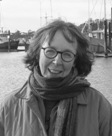Five Minutes with a Fellow offers a brief glimpse into what inspires researchers in the environmental humanities. The interviews feature current and former fellows from the Rachel Carson Center.

Carmel Finley is interested in the role of oceans as an intersection between science and politics. Her book All the Fish in the Sea: Maximum Sustained Yield and the Failure of Fisheries Management (University of Chicago Press, 2011) deals with the influence of the US State Department in the development of fisheries science between 1945 and 1958. Finley also maintains a blog about the history of fishing in the Pacific. A former newspaper reporter, in 2007 Finley completed her PhD in the history of science at the University of California, San Diego.
How does your research contribute to discussions around solving environmental challenges?
You can’t solve problems until you know how they were created. What were people thinking? What were the assumptions? This is especially true where fisheries are concerned. Scientists throughout the 1950s and 1960s thought the global fish catch would be between 200 and 400 million metric tons; the actual catch is around 90 million. The assumptions about fish productivity were way too high. The US State Department was very involved in influencing fisheries science, so it supported the American foreign policy goals of no restrictions on American planes, military vessels, submarines—and fishing boats. Science is always embedded in policy and you have to understand that context.
Because I was a newspaper reporter, it’s very important to me to write clearly, without jargon. I want anybody to be able to read my work. And I want to write about the essence of the problems—why did we overfish? What were we thinking? We know now that many of those assumptions from the 1950s weren’t correct, but the formal legal structure of fisheries management makes it difficult to incorporate more accurate science into policy. My project at the Carson Center is to look at why governments created the subsidies to build so many fishing boats. There were domestic and foreign policy pressures to expand fishing, from creating coastal employment and fish for export, to fishing as a high-seas territorial claim. Everybody knows there are too many boats; I want to understand why that happened. Maybe then we can discuss dismantling the subsidies and redirecting efforts into reducing the size of the fleet.
What is one change you would like to see happen to achieve a sustainable future?
If we’re going to have fish to harvest in the future, we need to change the focus of management from estimating harvest to maintaining the population structure of fish stocks and their ecosystems.
What is your favorite piece of environmental literature?
Dust Bowl by Donald Worster. I love its passion and its clarity. What he says about industrial capitalism—that the function of society is to facilitate the transfer of natural resources into wealth—that applies to all extractive industries, especially fishing.
Who has been a big influence on your work and life, and why?
When I met my husband, Carl, he was fishing for salmon out of La Push, on the Northwest Washington coast. I went fishing with him—never occurred to me I would get seasick, but I did, every trip. We managed the summer together and then we got married. I’ve been influenced by Carl’s passion for salmon—not just catching them, but understanding what needs to be done politically to protect them. I’ve also been influenced by many of the biologists I met over the years, who have uniformly been generous about sharing their expertise with me. I would especially cite Jim
Lichatowich, he’s the biologist who wrote Salmon Without Rivers. I met him when he was director of research at the Oregon Department of Fish and Wildlife and I was a reporter. He’s a very quiet, thoughtful man, and he’s influenced a wide range of people about salmon and their habitat.
When I decided to go back to school, I met Ron Doel at Oregon State, and he introduced me to Naomi Oreskes, my major professor. They both knew I had a book to write and they both helped me get the pieces and the skills I needed to do it.
Where is your favorite place to spend time with nature?
Carl and I like to kayak. Our favorite place is Cascade Head, at the mouth of the Salmon River, on the Oregon Coast.
Leave a Reply